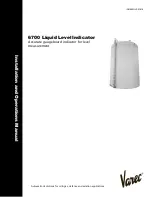
RANDOM*SOURCE
RANDOMSOURCE.NET
6
Serge NTO
Calibration
Calibration should be pretty easy if you follow these steps - please beware that tracking is dependent of the
oven temperature, i.e. changing the oven temperature requires (re-)calibration of the 1V/Oct trimmer!
Oven Temperature and Tracking
Connect the SAW output to speakers so you can listen to any changes.
Turn the TEMP trimmer all the way
down
(i.e. set the temperature as low as possible) - the pitch of the oscillator goes down as you lower the tem-
perature. This base temperature saves energy and should work well in normal (climatic) conditions. The module
will probably draw around 105mA now (depending on environment). Now feed a 1V/Octave signal into one of
the inputs and calibrate the 1V/OCT trimmer. Do not touch the TEMP trimmer again (or you’ll have to calibrate
the 1V/Oct again!).
Beware that changing the 1V/OCT trimmer by nature always affects the pitch: start out with A1, for example,
by playing that note on the keyboard and setting the pitch of the NTO to A1 (using COARSE and FINE knobs).
Then play A2 on the keyboard to see how far off the pitch is (most likely you get a fequency too high or too
low, i.e. the tracking is too steep or not steep enough). If you now change the 1V/OCT trimmer, you will move
A1 away from the pitch you set before at the same time - however, you will increase or decrease the frequency
range that a 1 octave jump in the keyboard (i.e. 1V into the 1V/Oct input) will cause. This is completely normal,
so the goal is to set the trimmer so that the distance is one octave regardless of the pitch. So one approach is
to keep jumping up and down 1 or 2 octaves and adjust the trimmer so that the range gets very close to the
desired 1 or 2 octaves (without worrying about pitch being in tune) - any once that is fairly close to use FINE and
COARSE to set the pitch precisely and then fine-adjust the trimmer for the desired precision.
If you’re obsessed about getting the maximum tracking possible, make sure you have a precision voltage source
(most keyboards are only roughly 1V/Oct - 1 cent corresponds to 1/1200th of a Volt) and that you also have a
very precise frequency counter / tuner - many tuners are not very exact in higher frequencies. However, if you
want to NTO to track over a normal, musically useable range, you should be able to get good results by ear or
with a tuner very quickly.
HF Compensation
The HF trimmer has a very subtle effect on higher frequencies - it will bring up those by a few Hz, which might
be barely audible, so you may not notice its effect unless you have a fairly precise frequency counter. I personally
do not care too much about HF adjustment and noticed that software tuners (e.g. in logic) do not seem to be
able to handle the high frequencies affected by compensation, anyway. So HF trimming is rather optional.

























